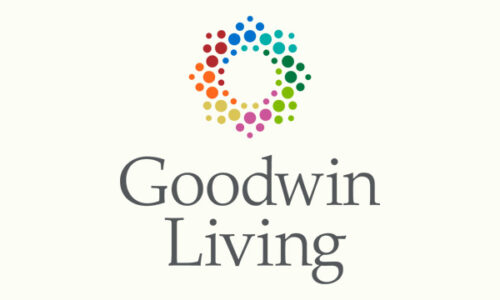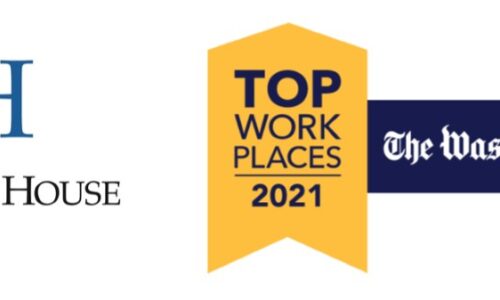When Calling Meets Career:
Q&A with Elizabeth “Beth” Klint, Executive Director of Goodwin Hospice
by Kathie Miller
Many of those who work in hospice will tell you that they consider their job a calling. Beth Klint is no different. She has turned this calling into a career, one that she finds deeply rewarding.
Beth serves as executive director of Goodwin Hospice, which has been in operation since 1997. After nearly 20 years delivering this specialized care only to residents of our Life Plan Communities, we expanded the program in 2016. We now offer hospice within other care settings and in private homes throughout Northern Virginia. We care for those ages 18 and older with a life-limiting illness wherever they are most comfortable, and we currently serve more than 100 patients daily.
In recognition of National Hospice Month, we asked Beth some questions about her chosen profession as well as her passion and vision for this specialized type of care that is all too often stigmatized.
What is your educational background and training?
I received bachelor’s degree in psychology from George Mason University in 1997, then worked at the American Psychological Association until I realized that I wanted to be a nurse. I moved to New York City (NYC) in 2002 to study at Columbia University and, through an accelerated program, I received my bachelor’s degree in nursing in 2003. I began my nursing career at New York University Langone Medical Center on a medical surgical floor with a respiratory focus. Once I gained my medical surgical experience, I transitioned to trauma nursing in the ER at Bellevue Medical Center, where I worked until 2008. I began my hospice career in 2007 at the Visiting Nurse Service of NY where I worked until I moved back to Virginia in 2011. I worked in D.C. as a hospice supervisor at Capital Caring until 2016, when I came to Goodwin Living.
How long have you worked at Goodwin Living? And what roles have you enjoyed here?
I came to Goodwin Living in December 2016 as the palliative care nurse for Goodwin Hospice. I served in that role until becoming the director of nursing for Goodwin House Bailey’s Crossroads (GHBC) in 2018. I loved my role in palliative care because it allowed me to combine primary care and end-of-life care. It also taught me a lot about the specialty of geriatric medicine, which was a great asset when I became director of nursing for GHBC.
What drew you to a career in hospice?
My mother was a hospice nurse for over 20 years, so I come by it honestly. After working in trauma for several years, I realized that I was drawn to the patient-driven model of care in hospice. So, I started working per diem as a hospice admissions nurse.
How long have you worked in hospice care?
Since 2008. While I continued in nursing, I took a break from palliative care and hospice from 2018 to 2021, when I was the director of nursing at GHBC.
You were director of nursing at GHBC during the worst of the COVID-19 pandemic. What did you take from that experience that applies to your perspective on hospice care?
Being the director of nursing during a pandemic was an extraordinary experience during which I learned to be nimble and empathetic. Having to make decisions for the benefit of a whole community versus for the individual taught me a lot about social responsibility. This time also showed that the loss of a member of our community is felt by the staff and other residents in a similar way to the loss of a family member. The wrap-around supports of social work, chaplaincy and bereavement [which are all standard services that Goodwin Living offers] are just as important as the direct medical and caregiving supports.
What is your vision for growing Goodwin Hospice?
I hope to continue to focus on the need for high quality aging services that are reliable and accessible to all who need care. I hope to meet the need for high quality end of life care by partnering with service-driven organizations across the whole care continuum. I believe that, as the need for services increases, we are going to need each other in order to be successful. Basically, we are stronger when we work together than when we compete against one another.
Why do you think there is stigma around hospice care?
Hospice deals with the uncomfortable topic of end of life that people often don’t discuss until faced with a terminal diagnosis. Death is often seen as something that can be avoided, and in medicine, death is often seen as failure. These perspectives of “failure” are even in the terminology – heart failure, respiratory failure, renal failure, etc. This sometimes means that to offer hospice you also must accept “failure”. We address this by reframing our definition of success.
In hospice, we start with the premise that death is the expected outcome and instead build our plan of care around the goals of the patient while involving the people supporting and providing care to the patient. This is not to say there is no hope in hospice; we simply redefine hope for this chapter of life.
Dispelling the Myths of Hospice
Thanks to Beth and her team at Goodwin Hospice, we are able to provide comfort care and redefine hope for hundreds of patients as well as their loved ones. We work collaboratively, not just among ourselves but with each patient’s network of medical care and support providers. We firmly believe there is life to be lived, even when we are facing a life limiting illness.
This November, in recognition of hospice month, we invite you to learn more about this specialized care. You can read more about six common myths and how to dispel them. Share what you learn with others. Together, we can remove the stigma around this care that can make all the difference when we need it the most.
———————————————————————
As Corporate Director of Marketing & Communications, Kathie Miller provides strategic guidance and tactical support for all areas of Goodwin Living. She writes, edits and manages The Good Life blog and newsletter. Kathie joined GHI in 2014 after nearly 15 years at NPR, where she honed her skills in brand and reputation management, content marketing and internal communications. Originally from Pennsylvania, Kathie has slowly come to realize she’s lived in Arlington for more than half her life and should call herself a Virginian. She enjoys the outdoors and brings her rescue dog, Remi, to work every day.





